|
Independence Day is a dangerous time for pets. The terrifying boom of fireworks send many cats and dogs into a panic as they try to flee the source of the noise. The result is a surge of lost pets, heartbroken pet parents, and animals impounded at shelters. July 5th is well known to be the busiest day for animal shelters.
With the current extreme overcrowding crisis being experienced in shelters throughout the country, it is particularly important that we keep our companion animals securely indoors. We need to do this not only for the benefit of each of them, but also for the hundreds of cats, dogs, rabbits, etc. already in our shelters who could be euthanized to make room for a flood of new arrivals. Even when a lost pet is reunited with their family from a shelter, their short stay there may have cost another animal’s life. And of course, running the streets in fear makes pets vulnerable to traffic, predators, and accidents. Keep your pets safe and out of the shelter this Fourth of July:
0 Comments
This letter was sent to the article's author, Emily Anthes. Her article can be found at https://www.nytimes.com/2024/04/16/science/australia-wildlife-cats.html?unlocked_article_code=1.k00.WwzV.dnX89H0ZCRhR&smid=em-share Dear Ms. Anthes,
I am the president and founder of Alley Cat Rescue, Inc., an international nonprofit that advocates for humane, compassionate treatment of cats. I was dismayed by the biased reporting in your article, “In Australia, ‘Cats Are Just Catastrophic.’” While I appreciate that you do mention Dr. Arian Wallach’s ‘pro-cat conservationist’ point of view, I wonder why you chose to relegate it to only a couple of short paragraphs and focus the article on Drs. Moseby and Read’s anti-cat theories. It would be best for the discussion of Australian wildlife conservation if widely-read and trusted publications such as The New York Times gave a more balanced exploration of the cat predation debate. In my hope that you will agree and follow up your article with another that delves into the possibility that cat predation is not among the most significant threats to Australian wildlife, and that, regardless, killing cats is a totally misguided method of preserving prey animal populations, I am sharing information collected across studies, books, and scientific articles. All references are provided to further your own investigation. I think you will find these sources fascinating and eye-opening. You write that cats “take an enormous toll on the world’s wildlife.” Yet that is a theory of some conservationists; it has not been proven, even in Australia. I won’t reinvent the wheel - I address the lack of science behind the this theory of page 100 of my book, Alley Cat Rescue's Guide to Managing Community Cats, where I write "The diet of cats has been studied on four continents, with at least 16 studies done in Europe, 12 in North America, 15 in Australia, and one study in Africa. 72 studies have been conducted on islands (Bonnaud et al., 2010), with most occurring on remote oceanic islands (Turner et al.).* And although these studies have helped identify the most common prey cats feed on and the many contributing factors as to why they feed on certain prey, few studies have examined the impact of cat predation on such prey populations…There simply is not sufficient information available to determine if cat predation has any detrimental effects on the overall populations of prey animals." You present cat predation in this article as a significant reason for the extinction of many species, and not as the opinion of Dr. Moseby or Dr. Reid, but as an accepted truth. When cats’ lives are at stake, it is irresponsible to highlight the alleged role of cat predation for the extinction of a species amongst numerous other possible and some proven causes. Gary J. Patronek, VMD, Ph.D. of Tufts University expressed the trouble with accepting the exaggeration of the little data we have eloquently in his letter to the editor of the Journal of Veterinary Medicine. The letter was written in 1996 but remarkably, and sadly, it is still relevant to the cat predation debate today: "Whittling down guesses or extrapolations from limited observations…does not make these estimates any more credible, and the fact that they are the best available data is not sufficient to justify their use when the consequences may be extermination for cats…What I find inconsistent in an otherwise scientific debate about biodiversity is how indictment of cats has been pursued almost in spite of the evidence." (DOI: 10.2460/javma.238.6.690). You explain also that killing the cats is one part of a multi-pronged approach to protecting the native animals living with and around Arid Recovery because both Drs. Read and Moseby acknowledge that it is not possible to eliminate all of the cats in the area. That leads me to wonder, if they accept that the cats are there to stay to some degree, why would they choose culling over sterilization to reduce the cats’ numbers? They are doubtlessly well aware of the arguments supporting sterilization as the most effective means of reducing cat populations over time. Perhaps they believe that the situation is too time-sensitive and that each cat eliminated will spare a significant number of wildlife. If that is the case, they should consider that sterilization decreases female cats’ hunting behavior because pregnant and nursing cats require more food than normal, and hunting behavior also decreases once cats reach six years of age (sterilized or not). If sterilization would decrease hunting by, let’s just say, one-third of the amount killing cats would in the short term and more than killing them would in the long term (as there would be fewer cats), it is unjustifiable to allow conservation concerns to outweigh moral arguments against culling. What’s more, killing cats in small groups could actually lead to an increase in their population over time. A 2014 study published in the journal Wildlife Research (DOI: 10.1071/WR14030) found that low-level culling of feral cats in Tasmania over a 13-month period resulted in an increase of 75% to 211% of known live cats during the culling period. When culling stopped, the numbers of cats gradually returned to pre-culling levels. Dr. Moseby says, “You have to make a choice between cats and wildlife.” I do not agree. It is my opinion, and Alley Cat Rescue’s official position, that all animal lives should be protected from human-caused threats. Sterilization and other non-lethal methods such as the fencing Arid Recovery already uses are the ways to accomplish this. The existence of domestic cats anywhere in the world beyond the region in Africa where they originated, is due to human expansion. Therefore, any threat they pose to biodiversity, if they do pose a threat, should not punish the cats - even if unintentionally. We need to clean up our own messes without harming innocent animals whenever possible and in the case of outdoor cats, it is possible. Sincerely, Louise Holton *Reference without link: Turner, Dennis C., et al. “The Domestic Cat: The Biology of Its Behaviour.” Hunting Behaviour of Domestic Cats and Their Impact on Prey Populations., edited by Patrick Bateson, Cambridge University Press, Cambridge, UK, 2000, pp. 152–175. 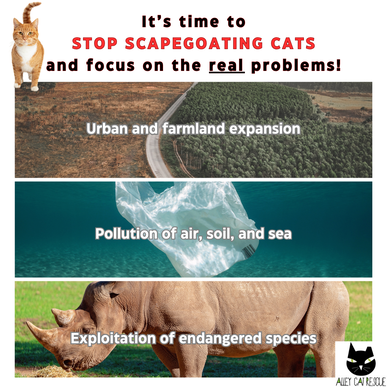 Earth Day is about protecting our living planet. The first step in doing that is identifying the greatest threats to the environment. Where wildlife and biodiversity are concerned, habitat loss due to human expansion is the clear frontrunner, as per World Wildlife Foundation’s Living Planet Report 2022 (along with many other credible sources). The report listed exploitation of organisms as the second biggest problem, followed by climate change, then pollution, and then invasive non-native species. Yet based on messaging by bird-specific conservation groups such as the American Bird Conservancy, and novelist Jonathan Franzen’s widely-read opinion piece in The New Yorker, one would think that cat predation is set to destroy ecosystems around the world. Apart from the fact that cats’ status as non-native or invasive is highly debatable since they have been living in many parts of the world where they didn’t originate for centuries now, there are much bigger dangers facing biodiversity. Encroachment of cities and farmland on wildlife habitats, chemical and plastic pollutants being dumped into the atmosphere and waters, and the inhumane trade of exotic animals for human gain are all problems that need to be addressed. Cats who roam outdoors undeniably hunt and kill some animals, and they do not discriminate between plentiful and endangered species. However, the effect cats have on the overall population of prey animals is still unknown. The few studies that have been conducted on cat predation are from islands with closed ecosystems, where local animals have not evolved with predators. Because cat predation on continents is very different from island environments, it is inaccurate and inappropriate to extrapolate data from these particular studies to predict predation on continents. In fact, some studies have even shown that cats protect endangered bird populations by preying on rodents who themselves eat the eggs and chicks of ground nesting birds. Even so, many organizations continue to vilify cats; it is easier to fundraise at the expense of cats than to challenge the big, powerful industries and popular luxuries that do the real damage to our planet. This is tragic because it causes culling and other forms of persecution of cats, and doubly tragic because it diverts needed energy from solving the true problems. The path to saving lives should not be the destruction of lives. We need to focus on mitigating the harmful impacts of one species alone, and that is us! In response to: https://www.vox.com/down-to-earth/24041534/hawaii-cats-invasive-species-extinction
Dear Mr. Jones and Vox Editors: I am the founder and president of Alley Cat Rescue, Inc., an international nonprofit organization that practices and promotes humane treatment of cats. I have studied and worked with feral cat colonies for over 30 years in South Africa, the U.K., and now in the U.S. I would like to offer an alternative opinion to several points you make, or present but do not dispute, in your article, “Hawaii’s out-of-control, totally bizarre fight over stray cats.” My hope is that you will be intrigued by the information offered in this letter and continue to investigate outdoor cat management with it in mind. The feeding ban at Queen’s Marketplace is misguided legislation. It is a common misconception that most feral cats roam. In reality, a group of cats will live out their lives within a small area that they view as their home and they defend this territory, keeping other cats away. For this reason, providing food does not attract massive amounts of new cats to a colony; populations actually increase because cats are prolific breeders and, as you highlight several times in the article, people abandon pet cats. Despite Lepczyk’s claim that even well-fed cats hunt, it must be obvious to him and others of the same mindset that well-fed cats at least hunt less. Cats are opportunistic feeders who have learned over centuries to scavenge for their food. Any location that has dumpsters and other sources of food waste can support a colony of cats. The difference between feeding these cats and leaving them to forage through is that the latter will cause them to supplement their diet by hunting more often. TNR stops the breeding cycle of outdoor cats and TNR programs remove kittens from outdoor cat groups. This helps to reduce the size of colonies immediately, but of equal importance, mature and senior cats become the remaining group residents. Cats older than six years hunt less than younger cats and pregnant and nursing cats also require more food than normal, so sterilizing cats definitely decreases hunting behavior. Furthermore, although outdoor cats prey on grounded birds, the protection they provide for the birds’ eggs and chicks from rats must be considered. Rats destroy nests, eating eggs and fledglings. The removal of cats from islands subsequently results in the rapid increase of rat populations. Mesopredator release has provided management lessons for eradication efforts that target both an invasive apex predator and an invasive mesopredator. For example, after cats were eradicated from Macquarie Island, near Antarctica, the rat population exploded, decimating the ground-nesting bird populations. Additionally, you present Raine’s argument that cat predation on native birds is more destructive than that of rats because rats kill eggs and chicks while cats kill adult birds too, and soon after share Jordan Lerma’s belief that “strays likely kill nēnē chicks more than adults.” Yet your own language surrounding the statements does nothing to acknowledge they contradict each other. You write, “Then there’s this whole question of how toxoplasmosis affects human behavior…Leaning on this evidence, some ecologists in Hawaii suggest that people who manage cat colonies — who refuse to stop feeding cats — are infected by toxo, which makes them irrationally invested in caring for these animals.” I understand this is not necessarily your opinion, but to even present it as a serious argument is insulting to cat caretakers and all community cat advocates, myself included. The danger of cats spreading toxoplasmosis gondii is greatly overblown by anti-cat conservation groups. From https://pets.webmd.com/cats/toxoplasmosis-cats: “It is important to understand the mode of transmission from cats to understand how minimal the risk is. Even a cat with an active toxoplasmosis infection is only capable of passing it on for seven to ten days of her entire life, when there’s an acute infection. It takes anywhere from one to three days for oocysts shed in the feces to become infectious…Then, to become infected from cat feces, a person would have to touch the feces and then touch an opening in their body.” Your article gives voice to the opinion of Christopher Lepczyk, and a few others you name, that scientific evidence shows TNR to be an ineffective way to control outdoor cat populations. However, cat advocates’ faith in TNR does not come from wishful thinking. There are plenty of scientific studies and real-world projects that show just the opposite. A wealth of research and links to studies on the efficacy of TNR, particularly in comparison with other methods of outdoor cat population management, is available on our website at www.saveacat.org/cats-and-wildlife.html. The final point in the article with which we take issue is the claim that outdoor cats have unpleasant and short lives. This is only true for (some) cats who do not receive a small amount of human care in the form of feeding and sterilization, such as what is provided by the caretakers your article criticizes. Sterilization in particular is key to optimizing a cat’s quality of life, whether they are a pet or feral. Neutered male cats rarely fight with one another, which spares them injury, and they roam far less, which helps them avoid falling victim to vehicles and predators. Female cats fare far better when they don’t experience the physical burdens of pregnancy and nursing. We at Alley Cat Rescue advocate for cats because we find they are among the most misunderstood and persecuted animals. That does not mean that we don’t love and appreciate the birds and other animals that can become prey to cats. However, we recognize the difference between natural animal deaths and unnatural, preventable ones at the hands of people. Cats live and proliferate outdoors due to decades of human neglect and mismanagement. From this perspective, we’ve failed them. Surely we should embrace a way to correct our mistakes that doesn’t punish the victims. Sincerely, Louise Holton It is with great joy and admiration that we come together on her birthday this year to celebrate the remarkable achievements of Louise, a true pioneer in the world of animal welfare. Her unwavering dedication and visionary efforts have not only transformed the landscape of feline advocacy but, in 1990 when only a handful of people were doing Trap-Neuter-Return (TNR), Louise brought it to the forefront of the animal welfare movement in the USA.
Louise's journey has been nothing short of inspirational. Through her passion, resilience, and compassionate spirit, she spearheaded the movement to make Trap-Neuter-Return a mainstream practice, revolutionizing the way we care for and protect our feline friends. Louise was with a friend after having dinner when they saw a bunch of cats and her friend looked at her and asked, what can do we do to help them? Louise said, as she continues to say today, "Trap-Neuter-Return”, which she had done herself countless times before in South Africa. Louise started two nonprofits, Alley Cat Allies and Alley Cat Rescue. Her vision and leadership have saved countless feline lives and laid the foundation for a more humane, sustainable approach to community cat management. In celebrating Louise, we recognize both her accomplishments and the ripple effect of her influence — a nationwide shift towards compassion and responsible stewardship of our feline companions. The impact of her work extends far beyond the realm of animal welfare; it is a testament to the power of one person's dedication to making the world a better place for those who cannot speak for themselves. As we express our gratitude and celebrate Louise’s birthday this year, let us also renew our commitment to the principles she championed. May her legacy continue to inspire us all to advocate for the well-being of animals, to embrace innovation in our approach to their care, and to foster a world where every cat can thrive. In response to: https://www.scientificamerican.com/article/cats-kill-a-staggering-number-of-species-across-the-world/
Dear Mr. Tamisiea and Editors: Alley Cat Rescue (ACR) is an international nonprofit focused on compassionate treatment of all cats. We are concerned that your December 12th article, “Cats Kill a Staggering Number of Species across the World,” is contributing to the demonization and scapegoating of cats that is pervasive in conservationist dialogue. Such theorizing is dangerous because it obfuscates far more significant threats to biodiversity, such as fragmentation of habitats by human development, and certainly puts a target on the backs of cats. Christopher Lepczyk is quoted as saying that the problem with cat predation can be solved by keeping pet cats indoors. ACR agrees that this should be the standard as a safety measure for both the cats and the wildlife they might hunt. However, feral cats are a different matter. As it is not possible to keep them indoors, claiming that cats are a grave threat to biodiversity turns public opinion against them and threatens their lives. (We feel compelled to add that this is a highly debated and debatable claim. Even the implications of the study examined by this article are questionable since, as you admit in the article, cats scavenge in addition to hunt. Therefore, isn’t it important to factor into any analysis of their prey the numbers of each species of animal, not just the number of species, cats killed themselves versus scavenged?) For now, the major point we would like to make is that, though some people may not appreciate them or even think much about them as they do pet cats, feral cats are equally sentient and deserving of life. Driven by this belief, we at ACR have been working for nearly three decades to reduce and manage feral cat populations through the only humane method, trap-neuter-return (TNR). Aggressively practiced TNR is not only effective but the MOST effective means of population control while catching and removing (often by killing the cats) is actually more expensive and only a temporary solution. When cats are trapped and removed from an area, new cats quickly move in to fill the vacated territory and take advantage of the resources that had been sustaining the cats there before them and start the breeding process all over again. This phenomenon is referred to as the "vacuum effect." One example of the vacuum effect is a 2015 study conducted in the forests of Tasmania, Australia. Over 13 months, researchers trapped and killed cats and by the end of the period, they found that the number of feral cats at the two target sites had actually increased by 75% and 211%. When the cat culling stopped, the researchers saw the cat population return to the same level as before the experiment had begun.* Whatever one’s concerns about outdoor cats’ effect on the environment, one cannot deny that 1) feral cats exist and 2) they have nowhere else to live. By using buzz terms like “terrorized” to describe cats’ interaction with native species and calling cats “biological invaders” and , this article is promoting anti-cat attitudes amongst the large audience of Scientific American. The fallout of this is persecution - killing - of feral cats. We hope that you will explore opposing information about cat predation from other scientists, as well as the well-studied efficacy of TNR programs, and spread that information. If you would like to be pointed to sources, please Email [email protected]. Sincerely, Louise Holton President / Founder of Alley Cat Rescue, Inc. *Reference: Lazenby, Billie T., et al. “Effects of Low-Level Culling of Feral Cats in Open Populations: A Case Study from the Forests of Southern Tasmania.” Wildlife Research, vol. 41, no.5 2014, pp. 407-20. In response to: https://www.nytimes.com/2023/12/12/climate/cats-nature-biodiversity.html
Alley Cat Rescue (ACR) is an international nonprofit focused on compassionate treatment of all cats. We advocate for keeping pet cats indoors, and entertaining them properly with exercise and “catios.” This is safest for the cats and it does of course prevent them from hunting wildlife. However, feral cats are a different matter. Though some people may not appreciate them or even think much about them as they do pet cats, feral cats are equally sentient and deserving of life. If their presence is destructive or unwanted, they cannot simply be kept indoors. This is why ACR has been working for nearly three decades to reduce feral cat populations through the only practical and humane method of trap-neuter-return (TNR). The article touches on TNR only to discount its efficacy, saying “research has shown that those efforts tend to have limited or no success in reducing populations unless they are performed at continuously high intensities.” Our immediate response to this is - where is the problem? TNR should be done consistently and aggressively, especially considering the enormous number of feral cats in the country in general. When TNR is done correctly, it is not only effective but the MOST effective means of population control while catching and removing (often by killing the cats) is actually more expensive and only a temporary solution. When cats are trapped and removed from an area, new cats quickly move in to fill the vacated territory and take advantage of the resources that had been sustaining the cats there before them and start the breeding process all over again. This phenomenon is referred to as the "vacuum effect." One example of the vacuum effect is a 2015 study conducted in the forests of Tasmania, Australia. Over 13 months, researchers trapped and killed cats and by the end of the period, they found that the number of feral cats at the two target sites had actually increased by 75% and 211%. When the cat culling stopped, the researchers saw the cat population return to the same level as before the experiment had begun.* The reason for the decrease in population after the study is because, when a colony of cats is neutered and returned to an area, the presence of the original cats will continue to keep other new (not-neutered) cats out. Whatever one’s concerns about outdoor cats’ effect on the environment, one cannot deny that 1) feral cats exist and 2) they have nowhere else to live. Even people who do not value the lives of feral cats must understand from research that trying to get rid of them would backfire. Widespread, focused TNR is the only real solution from a rational as much as moral standpoint. *Reference: Lazenby, Billie T., et al. “Effects of Low-Level Culling of Feral Cats in Open Populations: A Case Study from the Forests of Southern Tasmania.” Wildlife Research, vol. 41, no.5 2014, pp. 407-20. In response to: https://www.theguardian.com/environment/2023/dec/12/cats-diet-2000-species-conservation-study-aoe
Dear Ms. Weston and Editors: Alley Cat Rescue (ACR) is an international nonprofit focused on compassionate treatment of all cats. We are concerned that your December 12th article, “Killer kitties: cats are eating 2,000 species, including hundreds that are at risk,” is contributing to the demonization and scapegoating of cats that is pervasive in conservationist dialogue. Such theorizing is dangerous because it obfuscates far more significant threats to biodiversity, such as fragmentation of habitats by human development, and certainly puts a target on the backs of cats. As the article says, one remedy for cat predation would be to keep pet cats indoors. ACR agrees that this should be the standard as a safety measure for both the cats and the wildlife they might hunt. However, feral cats are a different matter. As it is not possible to keep them indoors, claiming that cats are a grave threat to biodiversity turns public opinion against them and threatens their lives. We feel compelled to add that this a highly debated and debatable claim, despite the study examined by this article. If you would like to explore this point further, we would be eager to follow up with more information at your request. For now, the major point we would like to make is that, though some people may not appreciate them or even think much about them as they do pet cats, feral cats are equally sentient and deserving of life. Driven by this belief, we at ACR have been working for nearly three decades to reduce and manage feral cat populations through the only humane method, trap-neuter-return (TNR). Aggressively practiced TNR is not only effective but the MOST effective means of population control while catching and removing (often by killing the cats) is actually more expensive and only a temporary solution. When cats are trapped and removed from an area, new cats quickly move in to fill the vacated territory and take advantage of the resources that had been sustaining the cats there before them and start the breeding process all over again. This phenomenon is referred to as the "vacuum effect." One example of the vacuum effect is a 2015 study conducted in the forests of Tasmania, Australia. Over 13 months, researchers trapped and killed cats and by the end of the period, they found that the number of feral cats at the two target sites had actually increased by 75% and 211%. When the cat culling stopped, the researchers saw the cat population return to the same level as before the experiment had begun.* One might expect that the vacuum effect could at least be overcome on an island by eradicating every cat on it quickly. The reality, though, is that it is close to impossible to determine if all targeted subjects have been killed, let alone identified, and when they are not, the breeding cycle will repopulate the area. A mistaken assumption that eradication is complete when it really isn’t can have disastrous consequences. Cats are especially prolific breeders and can reproduce at as young as four months of age, so a handful of undetected, unsterilized cats can multiply more quickly than many other species. Subsequent eradication campaigns will be necessary, increasing the cost of ridding an area of cats. Whatever one’s concerns about outdoor cats’ effect on the environment, one cannot deny that 1) feral cats exist and 2) they have nowhere else to live. By echoing the interpretations of the featured study’s authors, and without offering counter arguments nor solutions that would protect feral cats from culling, this article is predisposing the large audience of the Guardian to persecution of feral cats. We hope that you will explore opposing information about cat predation from other scientists, as well as the well-studied efficacy of TNR programs, and spread that information. If you would like to be pointed to sources, please Email [email protected]. Sincerely, Louise Holton President / Founder of Alley Cat Rescue, Inc. *Reference: Lazenby, Billie T., et al. “Effects of Low-Level Culling of Feral Cats in Open Populations: A Case Study from the Forests of Southern Tasmania.” Wildlife Research, vol. 41, no.5 2014, pp. 407-20. Shelter overcrowding is a problem across the country. This is the product of decades of mismanagement of companion animal breeding, but the pause of spay/neuter surgeries that occurred during the COVID-19 pandemic and current scarcity of veterinarians have brought the situation to new extremes. Los Angeles shelters are among those most dramatically impacted. Some L.A. shelter staff believe that they are seeing the WORST overcrowding their shelters have EVER experienced. Alley Cat Rescue volunteers have noticed the uptick in pleas coming from shelters for help with orphaned kittens. LA city shelters have lost the “no-kill” designation from Best Friends. L.A. Department of Animal Services Director, Agnes Sibal-von Debschitz, explained that much of the reason for the drop in live outcomes was because, starting in 2021, the shelters began receiving more orphaned kittens who required more care than shelters can provide and the shelters feel the most humane course of action is to euthanize those kittens (De Koos). Staycee Dains, the recently appointed General Manager of LA Animal Services (LAAS), said at an LAAS Commission meeting: “Our ratio of Animal Control Technicians to animals in the shelter is one to 85. The industry standard is one to 30.” Dains explained that animal care inadequacy is not only in the number of employees, but also in the work being done, saying, “We have a deeply demoralized staff” and that “some staff seem uneducated and frankly uninterested in animal behavior.” (MyNewsLA.com) Alley Cat Rescue appreciates Dains’ honesty and apparent understanding of the problem. We are also encouraged by her plan to expedite the hiring of “dozens” of vacant positions within the next month (MyNewsLA.com) and call for a moratorium on issuing breeding permits. Realistically, however, we recognize that many more lives will be lost as solutions are still being formulated. ACR members in Los Angeles, you can help save lives right now by participating in two critical roles!
If you’re not in L.A. City, your local shelter animals still need you! The crisis may be particularly bad in L.A., but it is still a problem everywhere in the U.S. References
De Koos, Camila Thur. “LA City Animal Services Loses ‘No-Kill’ Shelter Status.” LAist, 26 Jan. 2022, laist.com/news/la-city-animal-services-loses-no-kill-shelter-status. “LAAS Considers Halting Breeding Permits to Control Animal Population.” MyNewsLA.com, 12 Sept. 2023, mynewsla.com/life/2023/09/12/laas-considers-halting-breeding-permits-to-control-animal-population. Thirty-four states have an official fund from which they give grants for cat and dog sterilization. Most of these funds come from the sale of special license plates to individuals who want to support spay and neuter. While most states do not give grants to individuals, nonprofits and local shelters that facilitate spay/neuter services for low-income households are eligible to apply.
This is encouraging, although we would like to see more of the spay/neuter funds dedicated to TNR programs in addition to low-income pet sterilizations. Maryland, for example, has a terrific grants program specifically for community cat spay/neuter and vaccinations. The states listed here do NOT have a spay/neuter fund of any kind.
If you see your state on the list, consider writing your state legislatures about the need for state-sponsored sterilizations to combat the tragedy and health hazards of pet overpopulation. |
Details
AuthorAlley Cat Rescue is leading in the way in promoting humane and compassionate care for ALL cats. Archives
June 2024
Categories
All
|
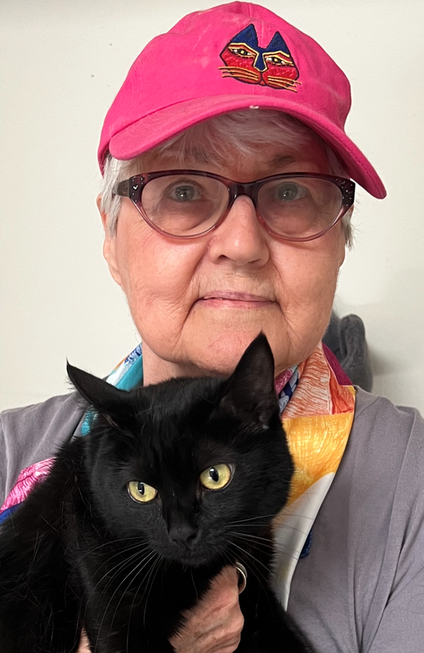
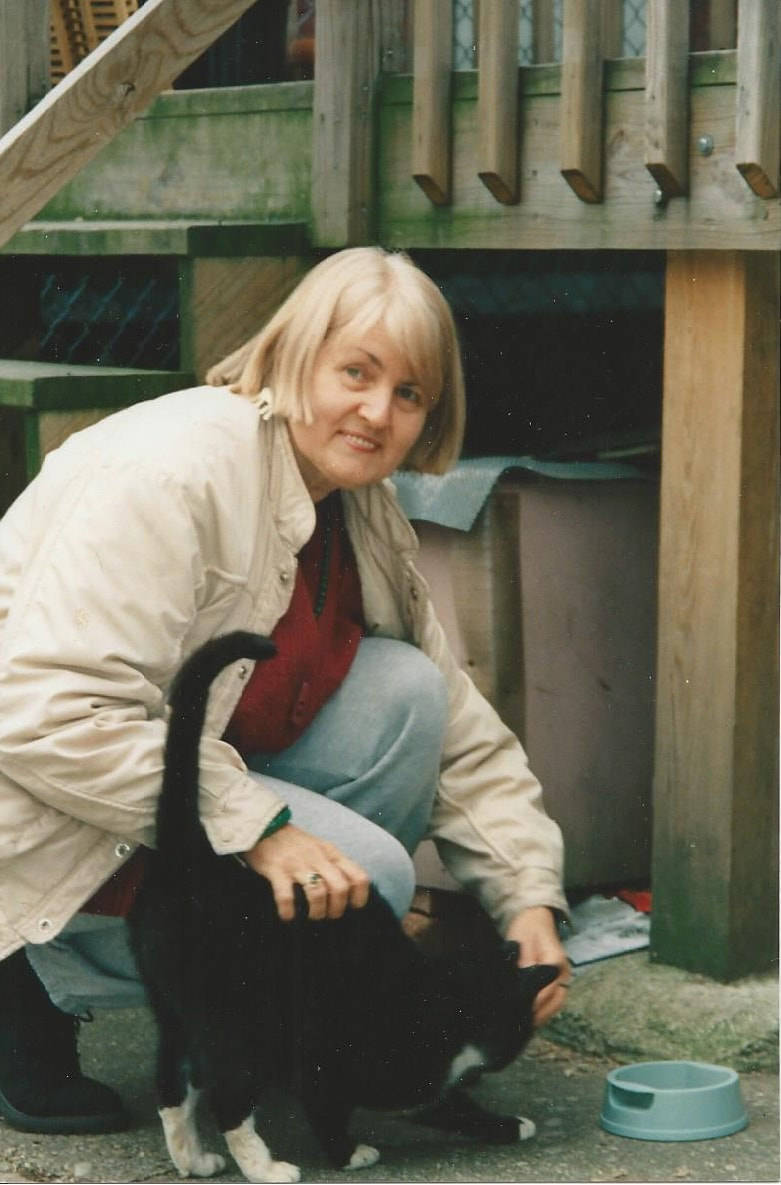
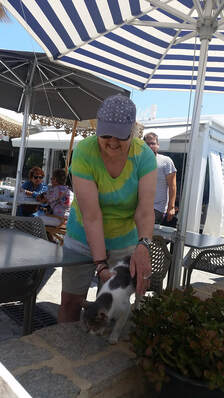
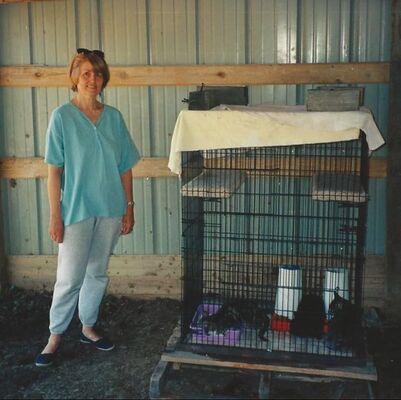
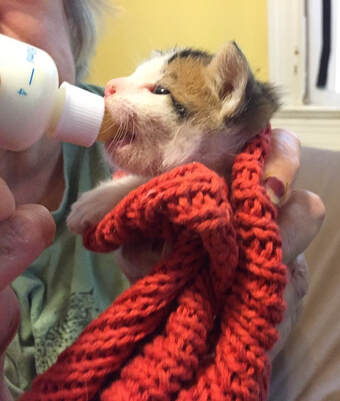
 RSS Feed
RSS Feed